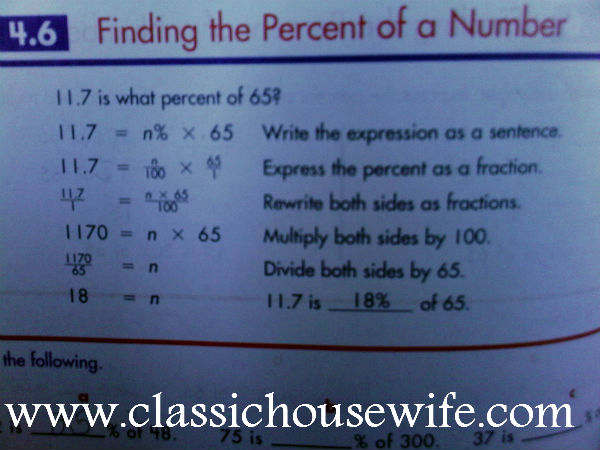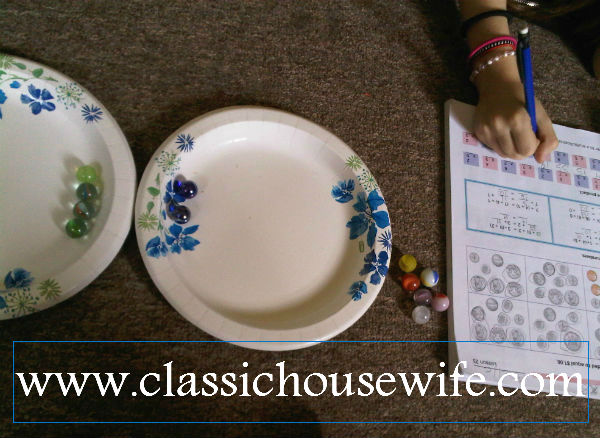Welcome back to our FINAL “episode” of the TEN DAYS OF TERRIBLE, HORRIBLE, NO GOOD, VERY BAD HOMESCHOOLING…

We’re going to wrap up with a subject that just makes me cringe. I mean, really. It’s intimidating and stressful and no fun to teach! Why? Because nobody likes Mom The Math Teacher…
~~

Let it be known: I like math. Well, I don’t love it, but I don’t hate it, either.
On the other hand… I don’t really like TEACHING it.
I suspect that there are many homeschool moms who would agree with me. It’s not the math that’s unpleasant, it’s the whining, the fighting with your child, the hair-pulling. It’s just not pretty. And it can be even harder when your teaching style doesn’t mesh with your child’s learning style. Frustration can build up until it explodes!
But we’d also all agree that math is important, right? It must be done! So, short of hiring a tutor to teach your children math– what can you do to survive the math-teaching experience and give your child what they need for math success?
10 Steps for Math Success:
1.) RELAX. It’s not a sprint, it’s a marathon.
Over the years I’ve developed the philosophy that rushing and pushing our way through math is of no benefit to anyone. Math is a life-long skill. It never goes away. So what good is pushing your child from one concept to the next before they are ready? Actually, this is detrimental to the learning process and brings more frustration. I want my children to be strong and confident in their math skills and so I let them proceed at their own pace. I released myself from any standards set by the masses (whatever masses they may be) because each child is created unique with their own strengths and weaknesses. I mean, yes, we use curriculum and we follow a scope and sequence set by someone else, but I’m not afraid to slow it down and set it aside to work on math facts longer, or speed it up and skip extra practice work that’s unnecessary. So take a deep breath and settle in for the long haul!

2.) Recognize Your Child’s Strengths & Weaknesses
My oldest daughter can remember her math facts but she can’t speed drill them verbally. She just can’t. And I’m okay with that. I’ll argue every family member who touts that my 12 year old ought to be able to answer basic math facts in 2 seconds or less (why is 5 or 7 seconds so bad anyway?) I’ve always recognized the fact that she needs to see the numbers so we make adjustments. Math is still not one of her strengths but she can succeed at it and doing her best is really all that I can ask of her, right? So as parents we need to ask ourselves – are we placing expectations on our child that just aren’t realistic? Are we falling prey to the thinking that our children have to excel at EVERYTHING for the sake of our homeschool reputation and pride? One of my goals as a parent and teacher is to give my child the keys to succeed in each subject and then push my child to excel in areas of strength and interest.
3.) Teach To Your Child’s Learning Style
Let’s be frank: learning style IS a factor. Regardless of how much stock you put into it, once you butt up against a child with an opposite learning style who doesn’t understand what you just explained 15 different ways, you have to face the fact that you’re just speaking different learning languages! My middle daughter is apparently left-brained. And I, on the other hand, am more right-brained. She’s more auditory and I’m more visual. One day it dawned on me after Big Daddy sat down and explained something to her (an explanation that sounded confusing and nonsensical to me) and she got it. They clicked. They learn the same way. One of the books that I use to assess and re-asses the kids’ learning styles is “How Your Child Is Smart.” There are various resources online as well. Taking learning style into consideration can affect the math curriculum you choose, the methods you use to practice facts, the way you explain new concepts.. and it can make the difference between having a frustrated meltdown and a successful “aha!” moment.
4.) Think Outside the Box
Sometimes taking the above things into consideration means I have to think outside my box a little. After explaining a concept a few times and not getting anywhere I have to change my tactics or go crazy trying the same things again. (I vote for NOT going crazy.) To solve the problem I stop and think about the child in question, I consider the piece of the concept that’s not getting through and then I try something new- it can’t hurt, right? For example.. Drama Queen recently had to learn how to follow the order of operation and add the numbers in the parenthesis FIRST and then the remaining number: (1 + 5) + 7, for example. Now yes, it doesn’t matter because the answer will be the same either way, but it’s setting her up for harder concepts right? After going roundy-round for a while, I got creative and pulled out 2 paper plates and Little Prince’s bag of marbles. 1 green marble and 5 blue marbles on one plate and 7 yellow marbles on another and poof! That was all she needed. All that hair pulling alleviated by a child’s toy!

5.) Call In the Re-Enforcements!
Sometimes no matter how hard I try, I’m just not making any sense to one kid or the other. It’s JUST. NOT. WORKING. These are the days that I’m thankful for being married to a man who works from home a lot and is good at math. = ) If he’s home and can take a minute I call Big Daddy in for a new perspective. But sometimes Big Daddy is not available. One such day I turned to the internet to save me and I was so glad I did! Princess was experiencing some frustration with long division. We turned to our favorite resource for instructional videos, Khan Academy. These math videos are made by MATH people. Unlike me, a creative no-math person, these people know not only how to DO the math but also how to TEACH the math.
6.) Observe Math Wherever You Go and Make It Real
Cooking and baking provides many opportunities to use both fractions and measurements in real life. Grocery shopping, yard sale browsing, banking.. these all provide opportunities for using money math as well as addition, subtraction, multiplication and division. Some crafts projects and hobbies (especially things such as beading) make use of patterns, dividing into even groups and maybe even things such as ordinal numbers and skip counting. There are a variety of daily life tasks that include math as well: telling time, checking the temperature, and so on. Involving the kids in these things does not only make math real but makes learning less painful (they’re having too much fun measuring sugar to care that they just multiplied 1/2 times 3.) Make your time-telling struggler the time keeper for the day or let your money-frustrated child spend a few dollars at a yard sale. Math is not some abstract concept solely made up to torture us. Basic math is a part of real life.
7.) Computer Games For Learning Math
Most kids really enjoy computer games. Mine do! There are tons of computer games – online and on dvd-rom – that are fun and reinforce math. They’re not all worth it, though, right? Some of our favorites are Math Missions, Timez Attack, Shepphard Software, Math Playground, and Math Is Fun. Math IS fun if it’s done right, right? Make computer math time a reward for having a good attitude during the lesson – double bonus points for mom. ; 0)
8.) Books for Math Fun
I’ve written before about reading books for math. If your child prefers reading over math, why not combine the two? We’ve recently discovered the Math Start series which Little Prince is enjoying. We’ve rented several others from the library. One of the cute books we found at the library is A Second is a Hiccup which covers units of time. It was very simple and cute, and effective, too.
9.) Math Videos for Math Facts and More
Youtube to the rescue! There are many, many, MANY math videos on youtube! How about counting by 5’s with School House Rock? Or there’s My Hero Zero. There are a variety of clips from tv shows such as Sesame Street and Cyberchase as well as a variety of math facts songs (some of them better than others!) You can also find money, time, shapes, whatever you need. If you’re having trouble on a specific concept you might need to set aside some time for searching but you can find a video to help.
10.) Board Games Can Sneak Math In, Too!!
Yes. Board games. Of course there are the obvious games such as Yahtzee but any game where you have to keep score uses addition. Games like Scrabble with double and triple letters and words also works on multiplication. Most games involve moving a certain number of counted spaces and many of them even involve play money. While playing games with your kiddos, make them in charge of keeping score, banking the money, or at the very least ask them to add up their own score for the turn for you to write down. I’ve also written about some of our favorite math tools before when I wrote about getting in some extra math practice. You can find more resource suggestions there!
After reading all of that it should go without saying that it’s important to find a good math curriculum fit for your and your child – and each of your children might do best with something different. (Mine do.) We can’t fit all of our children into the same math curriculum box!
What other ways might we make math more agreeable for both student and teacher? How do you cope with the math whines?
~~
 Thank you for following along on our journey through 10 Days of Terrible, Horrible, No Good, Very Bad Homeschooling! I hope you have enjoyed this as much as I have.
Thank you for following along on our journey through 10 Days of Terrible, Horrible, No Good, Very Bad Homeschooling! I hope you have enjoyed this as much as I have.
If you’re just now joining in, you can start at the beginning by clicking here.
“The 10 Days” Series is organized by iHomeschool Network, a collaboration of outstanding homeschool bloggers who connect with each other and with family-friendly companies in mutually beneficial projects. Visit them on Facebook, Pinterest, and Twitter.
To find ALL the blogs participating in this run of “The 10 Days” Series, click the image below, a collage of photos for all 28 ladies participating. You’ll be blessed with tips on how to handle bad days, cultivating curiosity, teaching with Legos, and much, much more. Many thanks to iHomeschool Network for organizing this fun blog hop!


Oh, math….we love it most days…not so much on others, but have incorporated many of your ideas!!! Thanks for this great list – pinning and sharing!!! Have really enjoyed your series! Thank you
Thank you, Rebecca! We have some good days. But those days where we have actual, real, fits over doing math? Notsomuch. =p
We love math! but are always looking for fun and creative ways to approach it, and I love your suggestions!! 🙂 I showed my daughter one of the game sites and she said “mommy, this is just the coolest!” 😛
Yay! I hope it stays that way. Neither of my girls minded math much until around 3rd grade. And that’s where it got interesting. School shouldn’t be as painful as a tooth extraction! For me OR them!! My oldest one gets frustrated because she doesn’t enjoy it and doesn’t want to do it and she let’s that drag her down and make her miserable. My middle gets frustrated anytime she doesn’t know how to do something – as if it’s she’s supposed to always have the answer and get it right! Teaching math is really more like teaching math AND… Read more »
I introduced my 12 year old kid to the youtube video and she has been finding it pretty informative to understand maths and other subjects. I am really happy that she is not mugging up things, she has started thinking logically..
A lot of children really think that Math is a horrible subject that is why it is important to let them learn and know that it is quite an enjoyable subject. But how do you convince them? Thank you for sharing your tips on teaching math here.
Excellent advice – we try hard to keep it alive; I really want my children to enjoy the learning process rather than just go through the motions of Maths…or moansions!!
Thank you!
[…] NOT MATH. =p Although, Drama Queen and Little Prince actually like math most days. All of my kids love to do […]
[…] 10 Tips for Teaching Math with Less Pain […]